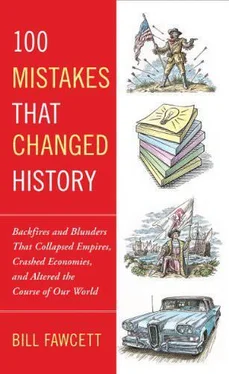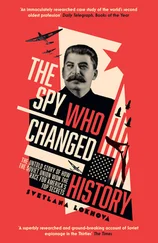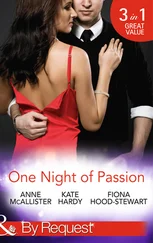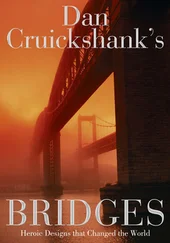Eventually, the crossbowmen moved toward the waiting English. It is surprising that, though they outnumbered the English six to one, the French made no effort to go around the position prepared by the English with pointed stakes; the entire French army just waited to charge in and slaughter the men who had done such terrible things to their land. The Genoese marched slowly toward the English until they stopped to fire their crossbows. But they stopped too far away for their bolts to do any damage to the English.
The range of the longbow was much farther and the rain of arrows that answered the Genoese’s single volley was deadly. Hundreds died, and the remainder turned and fled. After seeing the crossbowmen break through the first line of French knights, the horsemen could be restrained no longer. They charged forward, some riding down the retreating Genoese. But as they churned through the mud, the longbowmen began to fire.
The English archers could fire from six to eight arrows per minute. At that rate of fire, an archer could have another arrow in the air before his first one landed. Firing high, their first arrows fell from the sky almost vertically and easily penetrated the quilted padding protecting the knight’s horses. As the riders got closer, the arrows came in at a lower trajectory. Even at more than 200 yards away, a shaft fired from a longbow could penetrate the thickest armor worn by a knight. Several thousand French knights, many having already lost their mounts, were met by thousands of deadly arrows. Hundreds died, and the rest were forced to retreat. The men who were still on horseback joined thousands of fresh knights, just minutes later, in another charge across the muddy, body-strewn field. After they were driven back another charge formed, and then another.
The French made no fewer than a dozen charges. A few reached the barricaded archers, but they were driven back by the dismounted English knights. Charge after charge continued, until the bodies in the mud were so thick they slowed down the later attacks. By the time it was too dark for further fighting, 1,500 French knights were dead along with more than 10,000 of their less well-armored footmen. Fewer than 100 Englishmen were lost.
The English stayed in their position all night, and sure enough, there was another charge the next morning by knights who had arrived after dark. It too failed miserably. Edward was able to retreat with the loot from his chevauchée. It could be said that the tactics used by the French army were deeply flawed and a deadly mistake, but they weren’t organized enough to characterize the mistake as a tactical one. French chivalry was out of control. When they saw an enemy, they attacked; no tactical decisions were involved. It was such a colossal mistake that after Crecy the days of the mounted nobility were numbered. But at least it was a new mistake…
Sixty-five years later, in 1415, another English king, Henry V, was being pursued across France. He had landed months earlier with more than 10,000 men, but after a tough siege and after a large number of men decided to return to England, he had begun his own chevauchée across France with just under 6,000 soldiers of all types. In Paris, the French king John and his constable had appealed to the chivalry of the French. The army they gathered totaled more than 40,000: a quarter of these were mounted knights. This time, the English were brought to bay near the village of Agincourt.
Once more an English king formed his men into a crescent. Again there were woods on the English right, and this time the town of Agincourt was anchored to their left. The two armies formed up, thousands of French knights anxious to attack, but this time the French king managed to restrain his men. Maybe he had learned enough from history to not make the same mistake that had been made at Crecy.
Henry could not wait for the French. They could easily send a column around to the rear of his position that was larger than his whole army. He had to force a battle then and there. To do this, Henry advanced all 6,000 men toward the 40,000 angry French-men. The French knights must have watched in amazement as the audacious British approached. The English army stopped a mere 200 yards from the unformed mass of French horsemen. They were standing less than a minute’s ride away. There was no hope of retreat or escape.
Something needs to be mentioned at this point. There was another deterrent to attacking any set position with cavalry that day. The English on foot recorded sinking up to their boots in the sucking soil even before the battle began. Mud churns, and in the later French charges some of the survivors mention their horses sinking up to bellies and being barely able to move at all: unable to move as arrows rained death upon them.
The small English army then stopped and planted pointed stakes in front of the new position. The French, possibly still wondering what the English were doing, just waited. The stakes were ready very quickly when Henry V signaled for the longbowmen to begin firing. Each of the thousands of arrows fired in the next minutes could hardly avoid hitting someone in the ranks of the closely packed French position. Just sitting and taking the casualties was too much for the proud horsemen. The knight’s reaction was to ignore their king and charge the English. The chivalry of France surged forward just as they did at Crecy. Hundreds died as they were met with a cloud of arrows just as the earlier French chivalry had. Again, there was nothing lacking in the courage of the French. They charged and pressed forward under the archer’s hail of death. It must have seemed to the French that this time they were winning. Several times groups of armored men actually reached the English position and had to be driven off in hand-to-hand combat. The battle was so undecided that the English at one point had to slaughter noble prisoners worth many fortunes in ransom. This was almost unheard of at the time. After all, you might be the one captured next week.
The French dead were said to be stacked taller than a man stood. In front of some of the stakes and during the lulls in fighting, the English bowmen ran out between the lines to recover arrows as their supplies ran low. Finally, the French could stand no more, and their army retreated. On the ground in front of the 6,000 English lay more than 5,000 knights and nobles. Many of the greatest names in France had been slain. So many knights had died that French chivalry never again was able to dominate that nation’s neighbors with their massed, armored charges. At least as many common soldiers died with them.
King John of France likely never ordered that initial charge at Agincourt. Every military man in France was familiar with Crecy. The impetuous knights most likely acted on their own, repeating the disaster from two generations before. That makes the suicidal charge by the French at Agincourt a mistake that they had no excuse for. Many knights and nobles did know better and charged anyhow.
Agincourt effectively ended the Age of Chivalry. Had the French crushed the English and 10,000 mounted men survived it, history might be very different. How it would be different is another question. There was a good chance that King John would have returned the favor with a reprise of William the Conqueror’s invasion of England. Certainly, the French had enough to avenge. A French-dominated England would mean a history so different it can only be speculated on. Without the English tradition of the rights of man, would the revolutions of 1776 and 1789, which changed how nations were ruled forever, have even happened? If King John and his knights had not made the same mistake again, would we all be toasting each night to “the king” and perhaps speaking in French?
Читать дальше












